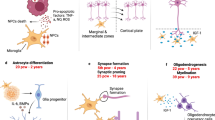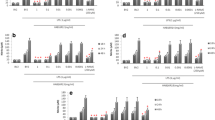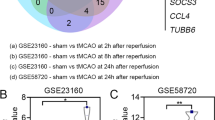Abstract
CtBP2 (C-terminal binding protein 2), which is widely expressed during developmental processes and differentiation, acts as a transcriptional repressor following recruitment to target promoters through repressors or other co-repressor proteins. In this study, we elucidated the dynamic expression changes and localization of CtBP2 in lipopolysaccharide (LPS)-induced neuroinflammatory processes in adult rats. CtBP2 expression was strongly induced in active glia cells (microglia and astrocytes) in inflamed spinal cord. In vitro studies indicated that the up-regulation of CtBP2 may be involved in the subsequent microglia activation following LPS exposure. And the knock-down of CtBP2 in microglia cell line HAPI by siRNA showed that CtBP2 increased the activation of microglia induced by LPS. Collectively, these results suggested CtBP2 may be important in host defense in microglia-mediated immune response. Understanding the cell signal pathway may provide a novel strategy against inflammatory and immune reaction in neuroinflammation in central nervous system.




Similar content being viewed by others
Abbreviations
- CtBP2:
-
C-terminal binding protein 2
- LPS:
-
Lipopolysaccharide
- CNS:
-
Central nervous system
- FCS:
-
Fetal calf serum
- TNF-α:
-
Tumor necrosis factor-α
- BCL-3:
-
B-cell lymphoma 3
- PAGE:
-
Polyacrylamide gel electrophoresis
- ECL:
-
Enhanced chemiluminescence system
- RT-PCR:
-
Reverse transcriptase PCR
- GFAP:
-
Glial fibrillary acidic protein
- NeuN:
-
Neuronal nuclei
- PCNA:
-
Proliferating cell nuclear antigen
- GAPDH:
-
Glyceraldehyde-3-phosphate dehydrogenase
References
Akira S, Uematsu S, Takeuchi O (2006) Pathogen recognition and innate immunity. Cell 124:783–801
Amat JA, Ishiguro H, Nakamura K, Norton WT (1996) Phenotypic diversity and kinetics of proliferating microglia and astrocytes following cortical stab wounds. Glia 16:368–382
Blander JM, Medzhitov R (2004) Regulation of phagosome maturation by signals from toll-like receptors. Science 304:1014–1018
Block ML, Zecca L, Hong JS (2007) Microglia-mediated neurotoxicity: uncovering the molecular mechanisms. Nat Rev Neurosci 8:57–69
Boyd JM, Subramanian T, Schaeper U, La Regina M, Bayley S, Chinnadurai G (1993) A region in the C-terminus of adenovirus 2/5 E1a protein is required for association with a cellular phosphoprotein and important for the negative modulation of T24-ras mediated transformation, tumorigenesis and metastasis. EMBO J 12:469–478
Brannon M, Brown JD, Bates R, Kimelman D, Moon RT (1999) XCtBP is a XTcf-3 corepressor with roles throughout Xenopus development. Development 126:3159–3170
Carmody RJ, Ruan Q, Palmer S, Hilliard B, Chen YH (2007) Negative regulation of toll-like receptor signaling by NF-kappaB p50 ubiquitination blockade. Science 317:675–678
Chao CC, Hu S, Peterson PK (1995) Glia, cytokines, and neurotoxicity. Crit Rev Neurobiol 9:189–205
Cheepsunthorn P, Radov L, Menzies S, Reid J, Connor JR (2001) Characterization of a novel brain-derived microglial cell line isolated from neonatal rat brain. Glia 35:53–62
Chinnadurai G (2002) CtBP, an unconventional transcriptional corepressor in development and oncogenesis. Mol Cell 9:213–224
Dechend R, Hirano F, Lehmann K, Heissmeyer V, Ansieau S, Wulczyn FG, Scheidereit C, Leutz A (1999) The Bcl-3 oncoprotein acts as a bridging factor between NF-kappaB/Rel and nuclear co-regulators. Oncogene 18:3316–3323
Deconinck AE, Mead PE, Tevosian SG, Crispino JD, Katz SG, Zon LI, Orkin SH (2000) FOG acts as a repressor of red blood cell development in Xenopus. Development 127:2031–2040
Doyle SE, O’Connell RM, Miranda GA, Vaidya SA, Chow EK, Liu PT, Suzuki S, Suzuki N, Modlin RL, Yeh WC, Lane T, Cheng G (2004) Toll like receptors induce a phagocytic gene program through p38. J Exp Med 199:81–90
Felts PA, Woolston AM, Fernando HB, Asquith S, Gregson NA, Mizzi OJ, Smith KJ (2005) Inflammation and primary demyelination induced by the intraspinal injection of lipopolysaccharide. Brain 128:1649–1666
Fujita T, Nolan GP, Liou HC, Scott ML, Baltimore D (1993) The candidate proto-oncogene bcl-3 encodes a transcriptional coactivator that activates through NF-kappa B p50 homodimers. Genes Dev 7:1354–1363
Glass CK, Saijo K, Winner B, Marchetto MC, Gage FH (2010) Mechanisms underlying inflammation in neurodegeneration. Cell 140:918–934
Hildebrand JD, Soriano P (2002) Overlapping and unique roles for C-terminal binding protein 1 (CtBP1) and CtBP2 during mouse development. Mol Cell Biol 22:5296–5307
Kato H, Takahashi A, Itoyama Y (2003) Cell cycle protein expression in proliferating microglia and astrocytes following transient global cerebral ischemia in the rat. Brain Res Bull 60:215–221
Keutgens A, Shostak K, Close P, Zhang X, Hennuy B, Aussems M, Chapelle JP, Viatour P, Gothot A, Fillet M, Chariot A (2010) The repressing function of the oncoprotein BCL-3 requires CtBP, while its polyubiquitination and degradation involve the E3 ligase TBLR1. Mol Cell Biol 30:4006–4021
Kreutzberg GW (1996) Microglia: a sensor for pathological events in the CNS. Trends Neurosci 19:312–318
Kuwata H, Watanabe Y, Miyoshi H, Yamamoto M, Kaisho T, Takeda K, Akira S (2003) IL-10-inducible Bcl-3 negatively regulates LPS-induced TNF-alpha production in macrophages. Blood 102:4123–4129
Lee KS, Yang WI (1992) Comparison of brain tumor growth kinetics by proliferating cell nuclear antigen (PCNA) and bromodeoxyuridine (BrdU) labeling. Yonsei Med J 33:265–271
Leung TH, Hoffmann A, Baltimore D (2004) One nucleotide in a kappaB site can determine cofactor specificity for NF-kappaB dimmers. Cell 118:453–464
Li S, Chen PL, Subramanian T, Chinnadurai G, Tomlinson G, Osborne CK, Sharp ZD, Lee WH (1999) Binding of CtIP to the BRCA1 repeats of BRCA1 involved in the transcription regulation of p21 is disrupted upon DNA damage. J Biol Chem 274:11334–11338
Luo XG, Ding JQ, Chen SD (2010) Microglia in the aging brain: relevance to neurodegeneration. Mol Neurodegener 5:12
Marik C, Felts PA, Bauer J, Lassmann H, Smith KJ (2007) Lesion genesis in a subset of patients with multiple sclerosis: a role for innate immunity? Brain 130:2800–2815
Merrill JE (1992) Tumor necrosis factor alpha, interleukin 1 and related cytokines in brain development: normal and pathological. Dev Neurosci 14:1–10
Morris GF, Mathews MB (1989) Regulation of proliferating cell nuclear antigen during the cell cycle. J Biol Chem 264:13856–13864
Nguyen MD, Julien JP, Rivest S (2002) Innate immunity: the missing link in neuroprotection and neurodegeneration? Nat Rev Neurosci 3:216–227
Olson JK, Miller SD (2004) Microglia initiate central nervous system innate and adaptive immune responses through multiple tlrs. J Immunol 173:3916–3924
Postigo AA, Dean DC (1999) ZEB represses transcription through interaction with the corepressor CtBP. Proc Natl Acad Sci USA 96:6683–6688
Raetz CR, Whitfield C (2002) Lipopolysaccharide endotoxins. Annu Rev Biochem 71:635–700
Ransohoff RM, Perry VH (2009) Microglial physiology: unique stimuli, specialized responses. Annu Rev Immunol 27:119–145
Rivieccio MA, John GR, Song X, Suh HS, Zhao Y, Lee SC, Brosnan CF (2005) The cytokine IL-1β activates IFN response factor 3 in human fetal astrocytes in culture. J Immunol 174:3719–3726
Saijo K, Winner B, Carson CT, Collier JG, Boyer L, Rosenfeld MG, Gage FH, Glass CK (2009) A Nurr1/CoREST pathway in microglia and astrocytes protects dopaminergic neurons from inflammation-induced death. Cell 137:47–59
Saijo K, Collier JG, Li AC, Katzenellenbogen JA, Glass CK (2011) An ADIOL-ERbeta-CtBP transrepression pathway negatively regulates microglia-mediated inflammation. Cell 145:584–595
Schaeper U, Boyd JM, Verma S, Uhlmann E, Subramanian T, Chinnadurai G (1995) Molecular cloning and characterization of a cellular phosphoprotein that interacts with a conserved C-terminal domain of adenovirus E1A involved in negative modulation of oncogenic transformation. Proc Natl Acad Sci USA 92:10467–10471
Shih YT, Hsu YY, Chang FR, Wu YC, Lo YC (2010) 6-Hydroxycleroda-3,13-dien-15,16-olide protects neuronal cells from lipopolysaccharide-induced neurotoxicity through the inhibition of microglia-mediated inflammation. Planta Med 76:120–127
Sofroniew MV, Vinters HV (2010) Astrocytes: biology and pathology. Acta Neuropathol 119:7–35
Streit WJ (2002) Microglia as neuroprotective, immunocompetent cells of the CNS. Glia 40:133–139
Trinchieri G, Sher A (2007) Cooperation of toll-like receptor signals in innate immune defence. Nat Rev Immunol 7:179–190
Wang J, Lee S, Teh CE, Bunting K, Ma L, Shannon MF (2009) The transcription repressor, ZEB1, cooperates with CtBP2 and HDAC1 to suppress IL-2 gene activation in T cells. Int Immunol 21:227–235
Wessells J, Baer M, Young HA, Claudio E, Brown K, Siebenlist U, Johnson PF (2004) BCL-3 and NF-kappaB p50 attenuate lipopolysaccharide-induced inflammatory responses in macrophages. J Biol Chem 279:49995–50003
Yu X, Baer R (2000) Nuclear localization and cell cycle-specific expression of CtIP, a protein that associates with the BRCA1 tumor suppressor. J Biol Chem 275:18541–18549
Zhou HF, Liu XY, Niu DB, Li FQ, He QH, Wang XM (2005) Triptolide protects dopaminergic neurons from inflammation-mediated damage induced by lipopolysaccharide intranigral injection. Neurobiol Dis 18:441–449
Acknowledgments
This work was supported by the National Natural Science Foundation of China (No. 30870320, No. 81070992 and No. 81172879); A Project Funded by the Priority Academic Program Development of Jiangsu Higher Education Institutions (PAPD).
Author information
Authors and Affiliations
Corresponding authors
Additional information
Guowei Zhang and Yaohua Yan contributed equally to this work.
Rights and permissions
About this article
Cite this article
Zhang, G., Yan, Y., Kang, L. et al. Involvement of CtBP2 in LPS-induced microglial activation. J Mol Hist 43, 327–334 (2012). https://doi.org/10.1007/s10735-012-9399-x
Received:
Accepted:
Published:
Issue Date:
DOI: https://doi.org/10.1007/s10735-012-9399-x




